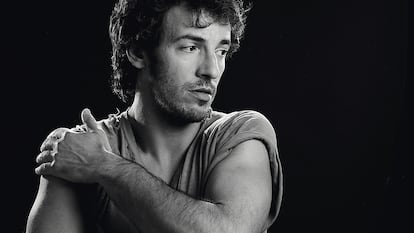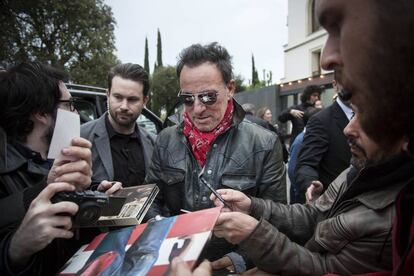Bruce Springsteen angers fans with latest tour’s ‘outrageous and exorbitant’ prices
Facing ticket costs from $200 to $5,000 based on an algorithm that changes the amount according to demand, die-hard fans feel the working-class hero has abandoned his principles

Jon Landau, Bruce Springsteen’s manager, attributes the high cost of tickets to a desire to combat resale and the use of a “dynamic pricing” algorithm that is not all that well calibrated. On July 20, tickets went on sale for six of the concerts on Springsteen’s 2023 U.S. tour: Tampa, Orlando, Hollywood (Florida), Tulsa, Denver and Boston. Barely 24 hours later, the community of the New Jersey artist’s ever-devoted fans was boiling mad: tickets were being sold at “obscene” prices, in excess of $5,000 in some cases. Moreover, the cheapest ones—theoretically $60—were nowhere to be found.
As Ron Lieber explains in a New York Times article about Ticketmaster’s “dynamic pricing system” for Springsteen’s concerts, “no scalpers were selling those tickets. Instead, a new definition of face value had emerged, one that many fans had never encountered.”
Music journalist Bill Werde, former editor-in-chief of Billboard magazine, also took to social media to express his dissatisfaction and shock: “Hard to believe that Bruce Springsteen turned out to be the one to make music fans miss scalpers.”
This is not our Bruce

What is strange in this case is that it involves the man who offered his rock music with roots and a conscience as an antidote to what he saw as the antisocial outburst of Ronald Reagan’s conservative counterrevolution. When your product is the proletarian ethic, you can’t sell it at the price of Iranian caviar.
More than a rock star, Bruce is the high priest of a contemporary religion with millions of followers. Its sacred books are albums like The River, Born to Run and The Wild, the Innocent & the E Street Shuffle, and its sermons on the mount, the ceremonies that fuel the sacred fire, are his concerts.
For his staunchest followers, the people who use their savings to follow Bruce from Dublin to Rome via Barcelona and Paris, a prohibitively priced ticket, or the lack of tickets altogether, is tantamount to expulsion from that community of believers. The emotional damage that this causes explains the degree of acrimony with which many of them are now revolting against their idol. As rock critic Jordi Meya wrote in RockZone magazine, “How much is a broken dream worth?”
Fifty years ago, Bruce Springsteen was more concerned about his fans’ pocketbooks. In December 1972, he performed for the first time in Ohio, at the Hara Arena in Dayton. He was the opening act for the New York doo-wop band Sha Na Na at a large venue with barely a thousand spectators that night. It was a somewhat dispirited concert, given before an unreceptive audience and under a poster that, because of an egregious mistake by the promoters, announced the performance of “Rick Springsteen.” But the main reason for Bruce’s complaint, as he explained the next day in a radio interview, was “the highway robbery” that a group of friends from New York who went to see him experienced when they had to pay more than $10 (the equivalent of about $70 today) for a ticket.

The 23-year-old Springsteen felt that spending five bucks to see a couple of bands was more than enough. If rock gave up its folk roots, it would die, he said. Of course, that Bruce was still very attuned to the bohemian coffeehouse and beach bar circuit of Asbury Park, on the New Jersey shore, the enthusiastic but precarious scene where he had been performing assiduously since 1969, both as a solo artist and in groups like The Castiles, Earth, and Steel Mill.
A few months later Greetings from Asbury Park, NJ came out, the album with which the Boss began his inexorable march to glory. After his rise from obscurity to incipient stardom, $10 became a pittance for seeing rock’s great white hope perform live.
A questionable defense
Returning to the present, Bruce and his representatives remained silent as the storm of criticism raged on social media. Finally, on July 26, almost a week later, Jon Landau—the former music critic who “discovered” Springsteen in 1974 at a concert in New York and has been the rock legend’s manager, spokesman and squire ever since—offered a series of technical explanations that have only added fuel to the fire.
Landau recognizes that a “modest number of tickets” are being sold at prices of over $1,000, but he asserts that the average cost per ticket has been in the mid-$200 range. According to Landau’s explanation, the higher prices are exclusively the result of a dynamic pricing algorithm, the function of which is to intelligently use the law of supply and demand, so that fans with more resources can get better seats close to the stage and help lower the price of the rest of the tickets.
“Dynamic pricing” refers to a flexible sales strategy that updates and adapts prices to changing demand in real time. Airlines and hotel chains have systematically used dynamic pricing for more than a decade. With the rise of e-commerce and advances in artificial intelligence, the sales strategy has been expanded to areas like large events. The principle is simple: an algorithm analyzes demand in real time and, if a particular location is in high demand, the price rises automatically; less-coveted locations tend to adjust their starting prices downward. In short, the idea is to “auction” each available seat to sell them at the ideal price.
The system tends to work best (and go relatively unnoticed) for events with medium or low levels of attendance. The least in-demand tickets drop in price and can end up being a real bargain if purchased at the last minute, while the most expensive ones remain at acceptable prices. However, for highly anticipated, in-demand events—such as Bruce’s tour—the only way to avoid major distortions is to establish maximum, minimum, and average starting prices.

Landau argues that if the cap were waived in this particular case, it would favor scalpers, who could buy at a lower price than the algorithm recommends and then resell the tickets at whatever price they want on the black market. In short, it’s a matter of widening the profit margin of artists and promoters by reducing that of scalpers. If someone is willing to pay more than $5,000 to see Bruce, why pay that amount to a criminal instead of Bruce and his business partners?
Beyond discussing mathematical models and the law of supply and demand, Landau contends that the abnormally high-priced tickets represent a “ridiculous” percentage and that it is perfectly possible to obtain “very decent” seats for “between $60 and $100,” a price he considers reasonable. Many fans responded to these claims on social media by posting screenshots to prove how difficult it was, especially for the Tampa concert, to buy tickets for less than $500 in most areas of the venue just a few hours after they went on sale, when many seats were still available.
Landau’s argument is questionable: Bruce has not done anything that other popular music stars like Drake and Taylor Swift—whose concerts pioneered the use of dynamic pricing systems without any price maximum —have not done as well. But perhaps the problem is that the Bruce Springsteen of a few years ago—the pride of working-class America—never would have appeared in the same sentence as Drake and Taylor Swift in the first place.
Amidst the controversy, some disenchanted fans brought up the fact that Bruce Springsteen is currently worth more than $650 million, and that he pays himself a yearly salary of $80 million as the manager of his own company. Moreover, in December 2021 he sold his music catalog and publishing rights to Sony for over $500 million, exceeding the $400 million that Bob Dylan received for selling his.
As Variety journalist Chris Willman explains, Bruce is now a very wealthy man who owes much of his wealth to the tremendous (and well-deserved) reputation of his live shows. At this point, expecting him to intercede so that his fans can see him play for the cost of a couple of beers is “supremely naïve.” With or without the algorithm, Bruce’s concerts will increasingly become a luxury that his diehard fans will not always be able to afford. Just like the Rolling Stones.
Tu suscripción se está usando en otro dispositivo
¿Quieres añadir otro usuario a tu suscripción?
Si continúas leyendo en este dispositivo, no se podrá leer en el otro.
FlechaTu suscripción se está usando en otro dispositivo y solo puedes acceder a EL PAÍS desde un dispositivo a la vez.
Si quieres compartir tu cuenta, cambia tu suscripción a la modalidad Premium, así podrás añadir otro usuario. Cada uno accederá con su propia cuenta de email, lo que os permitirá personalizar vuestra experiencia en EL PAÍS.
¿Tienes una suscripción de empresa? Accede aquí para contratar más cuentas.
En el caso de no saber quién está usando tu cuenta, te recomendamos cambiar tu contraseña aquí.
Si decides continuar compartiendo tu cuenta, este mensaje se mostrará en tu dispositivo y en el de la otra persona que está usando tu cuenta de forma indefinida, afectando a tu experiencia de lectura. Puedes consultar aquí los términos y condiciones de la suscripción digital.
More information
Últimas noticias
Most viewed
- Reinhard Genzel, Nobel laureate in physics: ‘One-minute videos will never give you the truth’
- Oona Chaplin: ‘I told James Cameron that I was living in a treehouse and starting a permaculture project with a friend’
- Pablo Escobar’s hippos: A serious environmental problem, 40 years on
- Why we lost the habit of sleeping in two segments and how that changed our sense of time
- Chevy Chase, the beloved comedian who was a monster off camera: ‘Not everyone hated him, just the people who’ve worked with him’











































